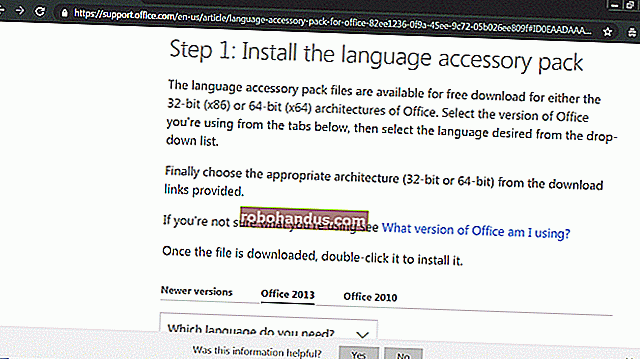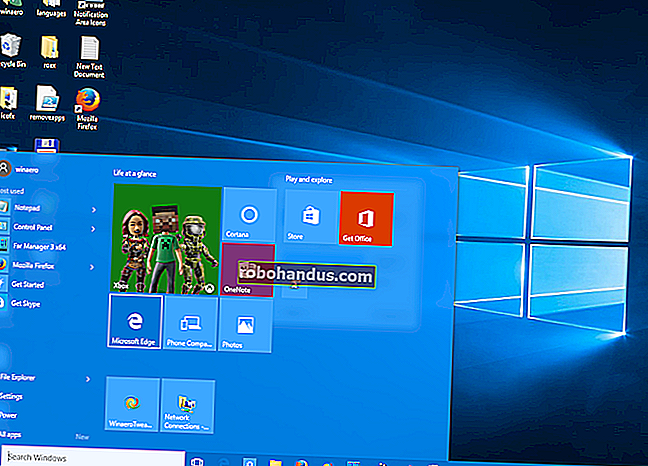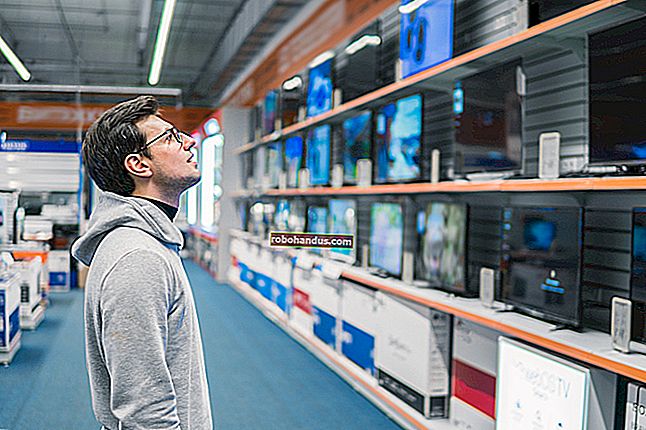Cara Memasang macOS High Sierra di VirtualBox pada Windows 10

Sama ada anda ingin sekali-sekala menguji laman web di Safari, atau mencuba sedikit perisian di persekitaran Mac, mempunyai akses ke versi terbaru macOS dalam mesin maya adalah berguna. Malangnya, anda tidak semestinya melakukan ini - jadi menjalankan macOS di VirtualBox adalah, paling tidak, sukar.
Kemas kini: Arahan di sini digunakan untuk versi macOS yang lebih lama. Sekiranya anda ingin memasang versi macOS yang lebih baru di VirtualBox, lihat skrip ini di GitHub. Ini berjanji untuk membawa anda melalui proses memasang dan menyiapkan mesin maya macOS. Kami belum mengujinya sendiri, tetapi kami telah mendengar perkara baik.Namun tidak mustahil. Sebilangan orang di forum InsanelyMac telah mengetahui proses yang berjaya. Satu-satunya perkara yang tidak berfungsi adalah baik, yang kerana sebab tertentu sangat terdistorsi atau tidak ada. Selain itu, ini adalah macOS High Sierra, berjalan lancar di VirtualBox.
Untuk menjadikan sesuatu menjadi lebih mudah bagi orang, kami telah menggabungkan kaedah dari beberapa rangkaian forum yang berbeza menjadi satu tutorial langkah demi langkah, lengkap dengan tangkapan skrin. Mari selami.
BERKAITAN: Pemula Geek: Cara Membuat dan Menggunakan Mesin Maya
CATATAN: Untuk mendapatkan ini berfungsi, anda memerlukan akses ke Mac sebenar untuk memuat turun High Sierra. Kami boleh, menurut kami, memperoleh ISO Sierra Tinggi dengan cara lain, tetapi kami tidak mengesyorkannya. Pinjam Mac rakan selama satu jam jika anda tidak memilikinya, dan anda semestinya baik-baik saja - semua perkara di luar langkah pertama tutorial ini dapat dilakukan pada PC Windows anda.
Sekiranya anda menggunakan Mac dan mahukan mesin maya macOS untuk digunakan pada Mac itu, kami mengesyorkan anda melihat Parallels Desktop Lite sebagai gantinya, kerana ia dapat membuat mesin maya macOS secara percuma dan jauh lebih mudah digunakan.
Bersedia untuk bermula? Mari melompat masuk!
Langkah Pertama: Buat Fail ISO High Sierra macOS
Untuk memulakan, kita perlu membuat fail ISO pemasang macOS High Sierra, jadi kita boleh memuatkannya di VirtualBox pada mesin Windows kita. Dapatkan Mac yang anda pinjam, pergi ke Mac App Store, cari Sierra, dan klik "Muat turun".

Apabila proses selesai, pemasang akan dilancarkan - tidak mengapa, tutup saja dengan Command + Q. Kami tidak mahu menaik taraf Mac rakan anda; kami hanya memerlukan fail yang dimuat turun.
Untuk menukar fail tersebut menjadi ISO, kita perlu menggunakan Terminal, yang boleh anda temukan di Aplikasi> Utiliti.

Pertama, jalankan arahan berikut untuk membuat gambar cakera kosong:
hdiutil buat -o /tmp/HighSierra.cdr -saiz 7316m -laman SPUD -fs HFS + J
Seterusnya, pasangkan gambar kosong anda:
hdiutil attach /tmp/HighSierra.cdr.dmg -noverify -nobrowse -mountpoint / Volume / install_build
Sekarang anda akan memulihkan BaseSystem.dmg dari pemasang ke gambar yang baru dipasang:
asr restore -source / Applications / Install \ macOS \ High \ Sierra.app/Contents/SharedSupport/BaseSystem.dmg -target / Volume / install_build -noprompt -noverify -erase
Perhatikan bahawa, setelah melakukan ini, nama titik pemasangan tujuan kami telah berubah menjadi "Sistem / Sistem Pangkalan OS X". Anda hampir selesai! Lepaskan gambar:
hdiutil detach / Volume / OS \ X \ Base \ System
Dan akhirnya, ubah gambar yang anda buat menjadi fail ISO:
hdiutil menukar /tmp/HighSierra.cdr.dmg -format UDTO -o /tmp/HighSierra.iso
Pindahkan ISO ke desktop:
mv /tmp/HighSierra.iso.cdr ~ / Desktop / HighSierra.iso
Dan anda mempunyai fail ISO High Sierra yang boleh di-boot!

Salin ke mesin Windows anda menggunakan pemacu kilat besar, cakera keras luaran, atau melalui rangkaian tempatan anda.
Langkah Kedua: Buat Mesin Maya anda di VirtualBox
Seterusnya, pergi ke mesin Windows anda, dan pasang VirtualBox jika anda belum melakukannya, pastikan anda mempunyai versi terbaru (serius, versi lama mungkin tidak berfungsi.)
Buka dan klik butang "Baru". Namakan Mesin Maya anda "High Sierra", dan pilih "Mac OS X" untuk sistem operasi dan "Mac OS X (64-bit)" untuk versi (seperti tulisan ini, "macOS High Sierra" tidak ditawarkan, tetapi tidak mengapa.)

Teruskan prosesnya. Untuk ingatan, kami mengesyorkan anda menggunakan sekurang-kurangnya 4096MB, walaupun anda boleh memilih lebih banyak sekiranya anda mempunyai RAM yang mencukupi untuk menggunakan mesin Windows anda.

Seterusnya, anda akan ditanya mengenai cakera keras anda. Pilih "Buat Cakera Keras Maya Sekarang" dan klik Buat.

Pilih VDI untuk jenis cakera keras dan klik Seterusnya. Anda akan ditanya sama ada anda mahukan pemacu bersaiz dinamik atau tetap. Kami mengesyorkan Tetap Saiz, kerana sedikit lebih cepat, walaupun akan memakan sedikit ruang cakera keras pada mesin Windows anda.

Klik Seterusnya. Anda akan ditanya seberapa besar pemacu yang anda mahukan; kami mencadangkan sekurang-kurangnya 25GB, yang cukup besar untuk OS dan beberapa aplikasi. Bergantung pada keadaan penyimpanan anda, anda boleh menawarkan lebih banyak, tetapi kami rasa anda tidak boleh menggunakan lebih sedikit daripada itu.
Klik arahan, dan anda telah membuat entri untuk mesin maya anda! Kini tiba masanya untuk melakukan sedikit konfigurasi.
Langkah Ketiga: Konfigurasikan Mesin Maya anda di VirtualBox
Anda harus melihat mesin maya anda di tetingkap utama VirtualBox.

Select it, then click the big yellow “Settings” button. First, head to “System” in the left sidebar. On the Motherboard tab, make sure that “Floppy” is unchecked.

Next head to the “Processor” tab, and make sure you have at least two CPUs allocated to the virtual machine.

Next, click “Display” in the left sidebar, and make sure Video Memory is set to at least 128MB.

Next, click “Storage” in the left sidebar, then click the “Empty” CD drive. Click the CD icon at the top right, then browse to the High Sierra ISO file you created earlier.

Be sure to click “OK” to finalize all the changes you’ve made, then close VirtualBox. No, seriously: close VirtualBox now, or the next steps won’t work.
Step Four: Configure Your Virtual Machine From The Command Prompt
We’ve made a few tweaks, but we need to make a few more more in order to convince the operating system it’s running on a real Mac. Sadly, there are no options for this from VirtualBox’s interface, so you’ll need to open the Command Prompt.
Open the Start Menu, search for “Command Prompt,” then right-click it and select “Run as administrator.”

You need to run a number commands, in order. Paste the following commands, pressing Enter after each one and waiting for it to complete:
cd "C:Program FilesOracleVirtualBox"
VBoxManage.exe modifyvm "High Sierra" --cpuidset 00000001 000306a9 04100800 7fbae3ff bfebfbff
VBoxManage setextradata "High Sierra" "VBoxInternal/Devices/efi/0/Config/DmiSystemProduct" "MacBookPro11,3"
VBoxManage setextradata "High Sierra" "VBoxInternal/Devices/efi/0/Config/DmiSystemVersion" "1.0"
VBoxManage setextradata "High Sierra" "VBoxInternal/Devices/efi/0/Config/DmiBoardProduct" "Mac-2BD1B31983FE1663"
VBoxManage setextradata "High Sierra" "VBoxInternal/Devices/smc/0/Config/DeviceKey" "ourhardworkbythesewordsguardedpleasedontsteal(c)AppleComputerInc"
VBoxManage setextradata "High Sierra" "VBoxInternal/Devices/smc/0/Config/GetKeyFromRealSMC" 1

That’s it! If everything worked, you shouldn’t see any feedback; the commands will simply run. If the command did not work, make sure your virtual machine is named “High Sierra” exactly; if it isn’t, edit the commands above putting your machine’s name in the quotes. Go ahead and close the Command Prompt. We’re heading back to VirtualBox now.
Step Five: Boot and Run The Installer
Re-open VirtualBox, click your Sierra machine, then click “Start.” Your machine will start to boot. You will see a lot of superfluous information as this happens—and I mean a lot—but don’t worry about it. It’s normal, even some of the things that look like errors.

You should only worry if a specific error hangs for five minutes or more. Just walk away and let it run for a bit. If you’ve done everything right, it’ll boot.
Eventually, you’ll see the installer asking you to pick a language:

Pick “English,” or whatever language you prefer, then click “Next.” Before you do anything else, however, click “Disk Utility” then “Continue.”

You won’t see the drive: don’t panic, High Sierra hides blank drives by default. In the menu bar, click “View” followed by “Show All Devices.”

You should now see your empty virtual drive in the sidebar. Click it, then click the “Erase” option.

Name the drive “Macintosh HD,” and leave the other two settings as-is: “Mac OS Extended Journaled” and “GUID Partition Map”. Do not create an AFS partition, because it will not work and you’ll have to start over with a new virtual hard drive. Click “Erase,” then close Disk Utility when the process is complete. You’ll be brought back to the main window.

Select “Reinstall macOS” then click “Continue.” You’ll be asked to agree with the terms.

Agree and you’ll eventually be asked to choose a hard drive; select the partition you just made.

The installation will begin! This might take a while, so be patient. Eventually your virtual machine will restart and take you…back to the installer. Don’t panic: this is to be expected.
Step Six: Boot Installer Stage Two From the Virtual Hard Drive
At this point the installer has copied files onto the virtual hard drive, and expects to boot from there. For whatever reason this does not work on the virtual machine, which is why you’re seeing the installer again.
Turn off your virtual machine and open its settings. Head to Storage, click “HighSierra.iso” in the “Storage Tree” panel, then click the CD icon at top-right and click “Remove Disk from Virtual Drive.” This will completely disconnect our installation ISO.

Now start up the virtual machine and you’ll see this lovely screen.

This is the EFI Internal Shell, and as long as you see “FS1” listed in yellow, you can use it to launch the rest of the installer. Click the virtual machine and allow it to capture you mouse and keyboard, then type fs1: and hit Enter. This will switch directories to FS1, where the rest of the installer is located.
Next we’re going to run a few commands in order to switch to the directory we need:
cd "macOS Install Data" cd "Locked Files" cd "Boot Files"
Now we can run the installer itself with the following command:
boot.efi

The installer will pick up where it left off. First you’ll see a series of text, like before, but eventually you’ll see the GUI installer come back. (Don’t worry, you only have to go through this process once.)

We’re getting there, just need a little bit more patience.
Step Eight: Log Into macOS High Sierra
Eventually the virtual machine will reboot again, this time into macOS High Sierra. If that doesn’t happen, try ejecting the ISO from the Virtual Machine. When High Sierra does boot, you’ll need to go through choosing your country, setting up a user, and the rest of the initial setup process.

Eventually, you’ll make it to the Mac desktop. Yay!

You can now try out any Mac software, though some functions, like FaceTime and Messages, won’t work because Apple won’t recognize your computer as a real Mac. But a lot of the basic stuff should work. Have fun!
Step Eight (Optional): Change Your Resolution
By default, your virtual machine will have a resolution of 1024×768, which is not a lot of room to work with. If you try to change the resolution from within macOS, however, you will see no option to do so. Instead, you need to enter a few commands.
Shut down your Virtual Machine by shutting down macOS: click the Apple in the menu bar, then click “Shut Down.” Next, close VirtualBox entirely (seriously, this step will not work if VirtualBox is still open!) and head back to Windows’ Command Prompt as an admin. You need to run the following two commands:
cd "C:Program FilesOracleVirtualBox"
VBoxManage setextradata "High Sierra" "VBoxInternal2/EfiGopMode" N
In the second command, you need to replace the N with a number from one to five, depending on what resolution you want:
- 1 gives you a resolution of 800×600
- 2 gives you a resolution of 1024×768
- 3 gives you a resolution of 1280×1024
- 4 gives you a resolution of 1440×900
- 5 gives you a resolution of 1920×1200
Start up VirtualBox, load up your virtual machine, and it should boot to your preferred resolution!
RELATED:10 VirtualBox Tricks and Advanced Features You Should Know About
From now on, you can open VirtualBox for any Mac-related testing you want to do. Again, you’ll see a lot of errors pop up during boot, but they’re fine; ignore them. Also, remember that audio won’t work, nor will things like FaceTime or iMessage, which require a real Mac. This isn’t going to be perfect, which is to be expected from an entirely unsupported setup. But it’s macOS, in a virtual machine, and that’s not bad! Be sure to check out our guide to VirtualBox’s advanced features to get the most out of your machine, too.
One more thing: a huge shout-out to Chad S. Samuels, without whom I could not have updated this guide for High Sierra. Thank you so much!






